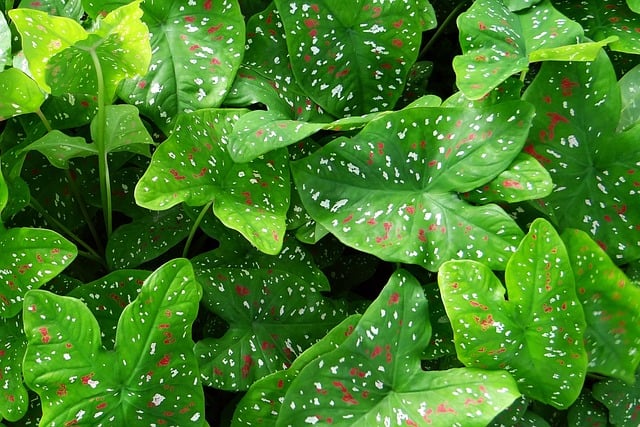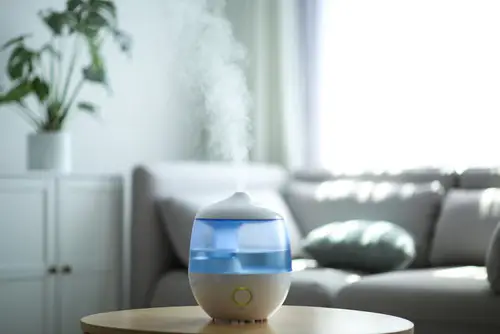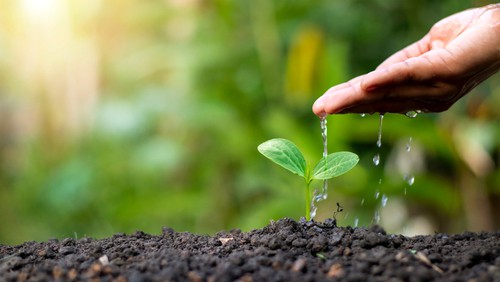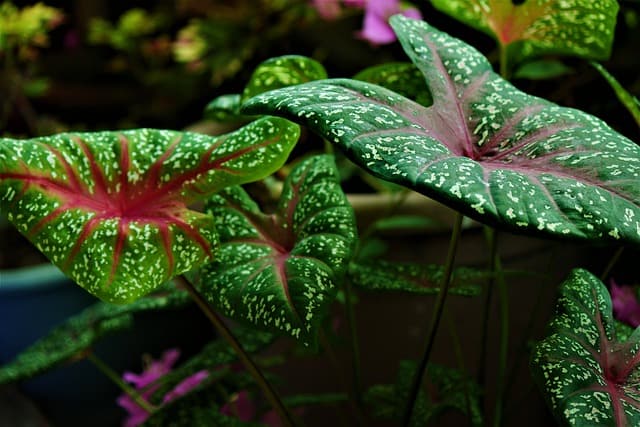Caladiums are a popular plant known for their beautiful, heart-shaped leaves that come in a variety of colors such as green, pink, and red. However, one common issue that many caladium owners face is yellowing leaves. If you notice your caladium leaves turning yellow, it could be an indication of a problem that needs to be addressed.
To understand caladium leaves turning yellow, it’s important to have a basic understanding of the plant itself. Caladiums are tropical plants that thrive in warm, humid environments.
They prefer to be planted in well-draining soil and require regular watering to keep the soil moist. When the leaves start to turn yellow, it could be a sign that the plant is not receiving the ideal conditions it needs to thrive.
Identifying the cause of yellowing leaves is key to treating the issue. Overwatering and underwatering are common culprits of yellowing leaves, but other factors such as nutrient deficiencies, temperature stress, and pest infestations can also contribute to the problem.
With proper care and attention, you can help prevent yellowing leaves and keep your caladium plant healthy and vibrant.
Key Takeaways
- Yellowing leaves on caladiums can be a sign of a problem that needs to be addressed.
- Caladiums prefer warm, humid environments and well-draining soil.
- Overwatering, underwatering, nutrient deficiencies, temperature stress, and pest infestations can all contribute to yellowing leaves.
Other top posts:
Understanding Caladiums

Caladiums are popular houseplants known for their beautiful foliage. These plants are native to South America and belong to the family Araceae. The botanical name for caladium is Caladium bicolor.
Caladiums are grown for their colorful leaves, which come in various shades of green, pink, red, and white. The leaves are heart-shaped and can grow up to 18 inches long. Caladiums are primarily grown for their foliage, and they do not produce flowers.
These plants are easy to care for and can thrive in a variety of conditions, making them a popular choice for indoor gardening. Caladiums prefer bright, indirect light and well-draining soil. They do not tolerate direct sunlight or soggy soil, which can cause root rot.
Caladiums are grown from tubers, which are planted in the soil with the eyes facing up. The tubers should be planted about 2 inches deep and spaced 12-18 inches apart. After planting, the soil should be kept moist but not waterlogged.
Ideal Conditions for Caladiums
Caladiums are tropical plants that require specific conditions to grow and thrive. In this section, we will discuss the ideal conditions for caladiums, including their sunlight requirements, temperature preferences, humidity needs, and soil preferences.
1. Sunlight Requirements
Caladiums require bright, indirect light to grow properly. Direct sunlight can scorch their leaves, while low light can cause the leaves to turn yellow and drop. Therefore, it is best to place caladiums in a location that receives bright, indirect light, such as near a north or east-facing window.
2. Temperature Preferences
Caladiums prefer warm temperatures between 70 and 85 degrees Fahrenheit. They can tolerate slightly cooler temperatures, but anything below 60 degrees Fahrenheit can cause their leaves to yellow and drop. Therefore, it is important to keep caladiums in a warm location, away from drafts and cold air.
3. Humidity Needs

Caladiums require high humidity to thrive. They prefer humidity levels between 60 and 80 percent. If the air is too dry, their leaves can turn brown and crispy. Therefore, it is important to keep caladiums in a humid location, such as a bathroom or near a humidifier.
4. Soil Preferences
Caladiums prefer well-drained soil that is slightly acidic. The soil should be moist but not waterlogged, as standing water can cause the roots to rot. Therefore, it is important to plant caladiums in a pot with drainage holes and water them when the top inch of soil feels dry to the touch.
Caring for Caladiums
Caladiums are a popular houseplant that can add color and texture to any indoor space. However, one common problem that many people face is yellowing leaves.
In order to prevent this issue, it is important to properly care for your caladium plant. This section will cover the proper watering procedure, fertilizing process, and potting guide for caladiums.
1. Watering Procedure
Proper watering is essential for the health of your caladium plant. Overwatering can lead to root rot and yellowing leaves, while underwatering can cause the leaves to wilt and turn yellow.
The correct watering procedure for caladiums is to water them thoroughly when the top inch of soil feels dry to the touch. It is important to ensure that the soil is moist but not waterlogged.
To avoid overwatering, it is recommended to use a moisture meter to check the soil moisture level. This will help you determine when it is time to water your plant. Additionally, it is important to ensure that the pot has proper drainage to prevent water from sitting in the bottom of the pot.
2. Fertilizing Process
Caladiums require regular fertilization to thrive. A slow-release fertilizer can be applied every three to four months during the growing season. It is important to follow the instructions on the fertilizer package and not to over-fertilize, as this can lead to yellowing leaves.
In addition to slow-release fertilizer, caladiums can benefit from occasional foliar feeding. This involves spraying a liquid fertilizer directly onto the leaves of the plant. This can help provide the plant with essential nutrients and prevent yellowing leaves.
3. Potting Guide

Choosing the right pot and soil is important for the health of your caladium plant. Caladiums prefer well-draining soil that is rich in organic matter. It is recommended to use a pot with drainage holes to prevent water from sitting in the bottom of the pot.
When repotting your caladium plant, it is important to choose a pot that is only slightly larger than the current pot. This will help prevent overwatering and ensure that the plant has enough room to grow.
Caladium Leaves Turning Yellow
Caladiums are beautiful tropical plants that are widely grown for their colorful heart-shaped leaves. However, yellowing of caladium leaves is a common problem that many gardeners face.
It can be caused by a variety of factors, including nutrient deficiencies, pests and diseases, overwatering and underwatering, sunburn, and low humidity.
1. Nutrient Deficiencies
Yellowing leaves may indicate that the plant is not getting enough nutrients. Nitrogen deficiency is a common cause of yellowing leaves. Other nutrient deficiencies, such as iron, magnesium, and zinc, can also cause yellowing of the leaves.
To remedy nutrient deficiencies, gardeners should fertilize their plants regularly with a balanced fertilizer.
2. Pests and Diseases
Yellowing leaves can also be a sign of pest infestation or disease. Root rot is a common disease that can cause yellowing of the leaves. Pests like spider mites, mealybugs, and aphids can also cause yellowing of the leaves.
To prevent and treat pest infestations and diseases, gardeners should inspect their plants regularly and take appropriate measures.
3. Overwatering and Underwatering

Overwatering and underwatering can cause yellowing of the leaves. Overwatering can lead to root rot, which can cause the leaves to turn yellow and wilt. Underwatering can also cause yellowing of the leaves, as the plant is not getting enough water to thrive.
To prevent overwatering and underwatering, gardeners should water their plants according to their specific needs.
4. Sunburn and Low Humidity
Yellowing of the leaves can also be caused by excessive sun exposure or low humidity. Sunburn can cause brown patches between the leaves, while low humidity can cause the leaves to turn yellow and wilt. To prevent sunburn and low humidity, gardeners should provide their plants with adequate shade and humidity.
Treating Yellow Leaves
Caladiums are known for their vibrant and colorful leaves, but yellow leaves can be a sign of underlying issues. Fortunately, there are several ways to treat yellow leaves and restore your caladium to its full beauty.
1. Addressing Nutrient Deficiencies
Yellow leaves can be a sign of nutrient deficiencies. If the leaves are yellowing but the veins remain green, it may be a sign of iron deficiency. In this case, adding an iron supplement to the soil or using a liquid fertilizer with iron can help.
2. Controlling Pests and Diseases
Pests and diseases can also cause yellow leaves in caladiums. Spider mites, thrips, and mealybugs are common pests that can cause yellowing leaves. Neem oil can be an effective treatment for these pests.
Fungal diseases like rust and botrytis blight can also cause yellow leaves. Southern blight control and root rot control can help prevent these diseases.
3. Correcting Watering Issues

Improper watering can also lead to yellow leaves in caladiums. Overwatering can cause the roots to rot, while underwatering can cause the leaves to wilt and dry out. It is important to water the caladiums when the top inch of soil is dry to the touch. If the soil is too dry, a drying out solution can help restore moisture.
4. Preventing Sunburn and Improving Humidity
Direct sunlight can cause sunburn on caladium leaves, leading to yellowing and wilting. It is important to place the plant in an area with indirect sunlight. Additionally, caladiums prefer high humidity, so using a humidifier or placing a tray of water near the plant can help improve humidity levels.
By addressing these issues, it is possible to treat yellow leaves in caladiums and restore the plant to its full beauty.
Common Caladium Problems and Solutions
Caladiums are beautiful and showy foliage plants that can add a pop of color to any garden or indoor space. However, they are not without their problems. Here are some common caladium problems and solutions to help keep your plants healthy and looking their best.
1. Drooping and Dying Caladiums
One of the most common problems with caladiums is drooping and dying leaves. This can be caused by a number of factors, including overwatering, underwatering, or natural aging.
To prevent this, it is important to water your caladiums properly and not let the soil dry out completely. Additionally, it is important to remove any dead or dying leaves to prevent the spread of disease.
2. Insect Infestations
Caladiums are also susceptible to insect infestations, such as thrips, mealybugs, spider mites, caterpillars, and aphids. These insects can cause damage to the leaves and stems of the plant, and can even spread disease.
To prevent insect infestations, it is important to inspect your plants regularly and remove any insects you find. You can also use insecticidal soap or neem oil to control the infestation.
3. Foliage Diseases

Caladiums can also be affected by foliage diseases, such as rhizoctonia and pythium species. These diseases can cause yellowing and wilting of the leaves, and can eventually lead to the death of the plant.
To prevent foliage diseases, it is important to avoid overwatering and to ensure that your caladiums are planted in well-draining soil. Additionally, it is important to remove any infected leaves and to treat the plant with a fungicide.
Frequently Asked Questions
How do I prevent my caladium leaves from turning yellow?
To prevent caladium leaves from turning yellow, it is important to ensure that the plant is not overwatered, as this is a common cause of yellowing leaves.
Additionally, caladiums prefer high humidity, so it is important to keep the plant in a humid environment. Providing the plant with appropriate light and avoiding extreme temperatures can also help prevent yellowing leaves.
What causes brown edges on caladium leaves?
Brown edges on caladium leaves can be caused by a variety of factors, including underwatering, overfertilization, and exposure to direct sunlight.
It is important to ensure that the plant is receiving the appropriate amount of water and fertilizer, and that it is not exposed to direct sunlight for extended periods of time.
Why are my caladium stems bending?
Caladium stems may bend if the plant is not receiving enough light or if it is overwatered. It is important to ensure that the plant is receiving the appropriate amount of light and water, and that it is not being exposed to extreme temperatures.
How do I know if my caladium is overwatered?
Overwatering can cause a variety of issues with caladiums, including yellowing leaves and stem rot. Signs that a caladium is overwatered include wilting leaves, mushy stems, and a foul odor.
It is important to allow the soil to dry out between waterings and to ensure that the plant is not sitting in standing water.
What is the best watering schedule for caladiums?
The best watering schedule for caladiums depends on a variety of factors, including the size of the plant, the pot size, and the environment in which the plant is growing.
As a general rule, it is important to allow the soil to dry out between waterings, as overwatering can cause a variety of issues with the plant.
What causes caladium leaves to lose color?
Caladium leaves may lose color if the plant is not receiving enough light or if it is overwatered. It is important to ensure that the plant is receiving the appropriate amount of light and water, as well as appropriate levels of humidity and fertilizer, to prevent loss of color in the leaves.

Hey, I’m Lisa and I’ve been an avid gardener for over 30 years. I love writing, talking and living in the garden! Feel free to connect with me on my socials below

